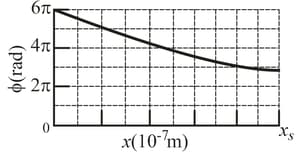The figure shows two isotropic point sources of light and that emit in phase at wavelength and at the same amplitude. A detection point is shown on the -axis that extends through source . The phase difference between the light arriving at point from the two sources to be measured as is moved along the -axis from to . The results out to are given in figure on the way out to . What is the greatest value of at which the light arriving at from is exactly out of phase with the light arriving at from ?



Important Questions on Interference
In the figure, two radio-frequency point sources and , separated by distance, , are radiating in phase with . A detector moves in a large circular path around the two sources in a plane containing them. How many (a) maxima and (b) minima does it detect?

In the figure, two isotropic point sources and emit identical light waves in phase at wavelength . The sources lie at separation on the -axis and a light detector is moved in a circle of large radius around the midpoint between them. It detects points of zero intensity including two on the -axis, one of them to the left of the sources and the other to the right of the sources. What is the value of ?

